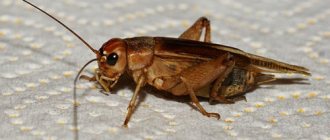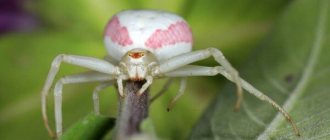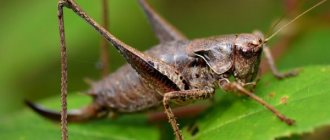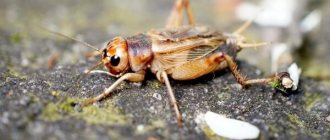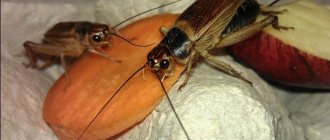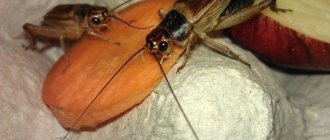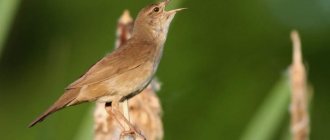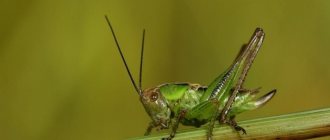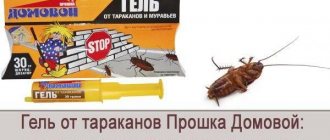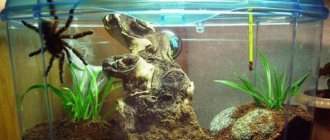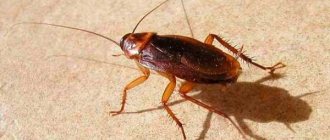- How a cricket sings
The cricket is perhaps a rare example of an exception among insects that does not cause disgust in people (such as the same
cockroaches), but on the contrary sympathy, curiosity. Since ancient times, his melodic singing has been associated with the hearth, coziness, and comfort. It’s not for nothing that the cricket is a favorite hero of many children’s fairy tales. The name of this insect comes from the Greek word for “singer”. If we resort to scientific classification, then crickets, like their relatives - grasshoppers, belong to the group of long-whiskered orthoptera insects, so named due to the possession of long mustaches and straight wings.
Description, characteristics, photo
House crickets are quite small in size; adult individuals can reach only 16 to 26 mm in length. The color of the domestic cricket is gray-yellow, also in different shades of brown, with streaks or spots of indeterminate shape.
The cricket's head is shaped like a flattened egg. Also on it (the head) there are three dark arcuate stripes. The cricket's eyes are located on the sides of the head; they have a complex facet structure. The cricket's mouth is of the gnawing type in structure. But the real pride of crickets is their large mustaches, which can sometimes be several times larger than the body of the crickets themselves. The cricket's whiskers serve a practical purpose - they are responsible for the sense of touch.
The cricket's wings are also well developed. The back pair of strong membranous wings helps them fly from place to place with ease. Crickets can also make relatively long flights. At rest, the cricket's wings are located along the abdomen; they look like sharp and long tails.
Like other orthoptera insects, the cricket has three pairs of legs. The back legs of a cricket with thickened hips are the strongest; they are designed for jumping, because it is no secret that crickets (as well as their relatives, grasshoppers) are simply excellent jumpers. But the front legs of the cricket also perform functions that are quite unusual for legs—the hearing organs are located on them.
Description and types
Crickets are close relatives of grasshoppers and belong to the group of long-whiskered orthoptera insects. Their name comes from the Greek word for "singer".
Entomologists distinguish several families and varieties of crickets:
- true - a family that is divided into 3 types: house, field and stem Far Eastern;
- Ants, also called ant-lovers.
House cricket
The house cricket is an insect whose homeland is considered to be the Far East and North Africa, where they have long lived next to people: in residential and industrial buildings. In the warm months, crickets move closer to nature, and with the onset of cold weather they again return closer to the warmth of human habitation. In the field, they dig holes up to 30 cm deep, and when going hunting or patrolling the territory, they cover it with a tuft of grass.
As can be seen in the photo of a brownie cricket, it is a gray-yellow insect, decorated with variegated and brown spots on the body and three stripes on the ovoid head, the length of an adult is 15-25 mm. The eyes are located on both sides of the head. Long whiskers stick out in front, larger in size than the insect itself, they serve as an organ of touch. The body is covered with a special chitinous shell, which protects from external influences and reduces moisture loss in the body.
House cricket
This type of cricket has wings that help them fly to the right place; when folded, they look like elongated tails. However, these insects cannot truly fly. It has 3 pairs of limbs: the back ones are stronger - designed for jumping, the front 2 pairs - serve as auditory organs.
Only males can make sounds and “sing,” which they successfully use to attract the attention of females and procreate. The sound apparatus of crickets consists of a stridulatory vein, which acts as a bow when friction against the left elytra of the insect.
There are 3 types of sound signals: when searching for females, when courting, and “hostile” sounds to scare away other candidates for the role of suitors.
Interesting!
Many ancient beliefs say that if there is a cricket in a house, it brings good luck and happiness, protects its inhabitants from evil and disease, and “promises” an easy birth to pregnant women. Therefore, it is not customary to get rid of such “vocalists” as unwanted guests. However, not all owners like the arias of insects that interfere with sleep. Therefore, people prefer to get rid of singing crickets that have settled in the apartment.
Unlike domestic insects, having settled in the garden and multiplied in large numbers, crickets can become pests, nibbling vegetables, especially melons.
Field cricket: photo and description
Field cricket
Insects of this species are common in Southern and Central Europe, Asia Minor and Western Asia, and North Africa. Habitats are well-lit fields and meadows, pine forests, where they make burrows up to 20 cm deep.
The dimensions of the field cricket are larger compared to other species: females are 17-22 mm, males are slightly larger (up to 26 mm). The body color is shiny black, sometimes brown, decorated with orange spots. The head is rounded with two antennae, and there are 3 ocellia (simple eyes) on the forehead.
Insects are omnivores, but prefer to feed on the leaves and roots of herbaceous plants, and occasionally catch small representatives of the fauna or eat their corpses.
Stem crickets
Stem crickets
The Far Eastern or stem species belongs to the family of true crickets, another name is “eastern trumpeter”. Insects have a light green elongated body up to 13 mm long; a black stripe runs along the bottom of the abdomen.
They got their first name because females lay eggs in the stems or petioles of plants, in each clutch there are 2-4 eggs. Larvae emerge from eggs in mid-summer; they are smaller in size compared to adults; wings are present in the form of rudiments. In August-September they turn into adults.
The second of the names indicates where the cricket lives: it lives in the Russian Far East, as well as in China and Japan.
Ant lovers
The smallest in size - ant crickets - reach 3-5 mm, they have no wings, and in appearance they are similar to cockroach nymphs. They are not capable of making any sounds and cannot even hear them.
This family lives in South America, where it was discovered by the Swiss entomologist A. de Saussure at the end of the 19th century. Now this species is also found in Europe. Their place of residence is associated with ant nests: larvae and adults overwinter in the anthill, the development cycle of larvae from eggs lasts 24 months. and consists of 5 stages.
Ant lovers
How a cricket sings
Sexual differences in crickets are manifested in the presence of a special sound apparatus in males, capable of producing “signature” cricket trills. Yes, only male crickets sing (or rather play) and in such a simple way attract the attention of females with the eternal goal of continuing their kind. The sound apparatus of crickets itself is similar in structure to that of grasshoppers, but it is even more complex. The sound of crickets is made by
friction of a special stridulatory vein, essentially performing the function of a bow, on the left elytra of the cricket.
Shar-headed grasshoppers (family)
Members of this family, which includes 15 genera, are so similar in many ways to true grasshoppers that they are often considered just a subfamily within this family. The main characteristic of ball-headed animals, as can be understood from the name, is a spherical (not flat) head.
Antennae are attached to it below the eyes. Representatives of the family also have short elytra. On the tibia of their forelimbs there are auditory slits, which is typical for grasshoppers. Now let's describe some of them.
Grape efippiger
The insect has a body size of no more than 3 cm. The back of the head of such creatures can be blue-black, and the rest of the body can be greenish-blue or yellowish. The elytra, which have a rusty-red tint, are shortened, and this type of grasshopper does not have wings at all.
Their pronotum is raised at the back, which is a characteristic feature of the variety. It is because of this feature that its representatives received the nickname “saddle bearers.” They are found in cold areas of Europe, mainly in the central regions and in the south.
Sevchuk Servilya
The body color of such insects is dark brown. The size for grasshoppers is average, but the build is special, not slender and graceful, but overweight and thick. The pronotum is outwardly prominent, it is very long and has the appearance of a flat shield, it has a complex yellowish pattern, and large teeth stand out on its back part.
The wings of these creatures are shortened or even underdeveloped. They live mainly in the steppes and feed on local vegetation, staying close to the ground and not rising high. Distributed in Eurasia, not numerous, and therefore protected.
Steppe fat man
For grasshoppers, such creatures are unusual in appearance, and the variety is already rare. These are large insects, the largest are males, reaching in some cases 8 cm. The color of the back of the grasshoppers is black, and the front area has a bronze or metallic tint, which, combined with the unusual shape, makes this part of the body look like armor.
However, there are other color options. A characteristic feature of the variety is a pair of longitudinal stripes on the abdomen. Such grasshoppers are found in Europe, including some regions of Russia, in particular in the Volga region, the Caucasus, and on the coast of the Azov and Black Seas.
Habitats
The habitat of the domestic cricket is very wide; they can be found all over the world, in many European countries (including our Ukraine), in North Africa, Asian countries and even in southern Australia. But in American
Crickets were once not found on the continent, but they were successfully brought there by European settlers.
Their favorite habitats are human dwellings (hence the prefix “home” to the name of crickets), warm basements, warehouses, and heating power lines. During the warm season, crickets can live outside human buildings.
The benefits and harms of field cricket for humans
The field cricket is considered a pest. It is unpretentious to food, so it can feed on almost any garden plants, and especially loves seedlings. This leads to a slowdown or complete stop of growth and a decrease in plant productivity.
But you need to pay attention to the fact that the insect also brings benefits. It hunts other pests, helping to reduce their numbers in the area.
It is important to consider that due to the loss of natural habitat, the population of field crickets has begun to decline. Therefore, the species is in the Red Book in some countries. In Russia, for example, the insect is on the verge of extinction in the Tula region.
Nutrition
Crickets are omnivorous insects that feed on both plant foods and can attack small invertebrates and eat other small insects, thus satisfying their need for protein supplements, which are necessary in the diet of every cricket.
Interesting fact: crickets can even attack each other, eating their smaller relatives; as you can see, facts of cannibalism are very common in the world of insects. Now you know the answer to the question of what do crickets eat?
External features
The adult field cricket is small in size, rarely exceeding a couple of centimeters. Body color is black. Each individual has 3 pairs of legs and 2 pairs of wings. In the photo of a field cricket you can clearly see a pair of antennae. They serve for orientation in space, as well as an organ of touch that allows you to feel the world around you. The body consists of the head and abdominal sections. It is covered with a protective chitinous layer.
On a note!
The wings of the individual are not adapted for flight, so the insect prefers to move on the ground or by jumping. For jumping, it has developed long hind legs.
Reproduction
Crickets have polygamous relationships, each male is the owner of a certain territory, which is inhabited by several females who are part of a kind of harem of this male. If another male encroaches on the territory of this male, fierce fights occur between them.
An obligatory attribute of the mating games of these insects is the famous trills of crickets, performing their musical serenades, the male attracts the female for mating.
Crickets breed throughout the year, but their peak sexual activity occurs in the summer. A fertilized female cricket prepares holes in the ground where she lays her eggs, somewhat similar to bananas. During one oviposition, a female cricket can lay from 40 to 179 eggs.
After one to two months (depending on the temperature and the environment in general), larvae begin to emerge from the eggs. The larva in its appearance resembles an adult cricket, but in order to become one, it will have to go through 10 molts, occurring over 7 weeks, during which the body undergoes restructuring. After the last molt, the larva produces a normal, mature cricket.
Lifestyle
These insects prefer a nocturnal lifestyle. During the day, they mostly hide in crevices and hard-to-reach places. With the onset of cold weather, crickets hibernate.
Males are their big owners. Protection of their territory and females is above all else for them. It’s not easy for a discovered rival on their territory. A mortal fight cannot be avoided, in which the loser is eaten by the winner.
Yes, that's exactly what happens. Cannibalism is common among crickets. In some countries, this warlike nature of these insects is used in fights between insects.
Breeding at home
In some countries, cricket breeding even takes on industrial proportions, for example, in China they are bred specifically for the purpose of subsequent use as food (Chinese gastronomic traditions are known for their originality). And some people raise them simply as unique, original pets. Below we describe some recommendations for breeding crickets at home.
Are they useful or harmful?
Crickets are often used:
- as bait for fishing;
- as food for exotic spiders or captive reptiles.
Insects are quite easy to breed. It is necessary to maintain a sufficiently high temperature (about + 30 ℃), supplement the lighting of the insectarium and add plant and protein products to the diet.
In Asian countries, crickets are traditionally used as food, usually fried or dried, as these creatures are rich in complete proteins.
In Japan, some crickets are kept in small cages as pets. The owners listen to their songs with pleasure.
Cricket matches have been played in China for a thousand years. Since wagering is prohibited, fighting is considered illegal.
Interesting fact! In some US states, snacks similar to crickets are sold: flavored, onion, dill, etc.
Stem crickets (blower crickets), when present in large numbers, can cause damage to vineyards and tobacco plantations.
Interesting Facts
- Since ancient times, crickets have been especially revered in China and Japan, in these countries they even organized special competitions for singing domestic crickets, and the rich people there were ready to give entire fortunes for the winners.
- Since ancient times, it was believed that having a cricket in the house brings good luck, prosperity, and well-being.
- According to recent research by scientists, the trills of crickets have a beneficial, calming effect on the human psyche. Only the purring of a pet has a similar positive effect on a person.
cats.
Natural enemies
There are several enemies that eat crickets in the wild. They serve as food for birds, lizards, frogs and some spiders.
Recently, scientists discovered that insects are threatened by the spread of a parasitic organism in their populations: Nosemagrylli microsporidium.
Often the enemy of crickets is a person who wants to get rid of uninvited musicians.
Video
And in conclusion, we invite you to listen to the sound of a cricket in the video yourself.
Author: Pavel Chaika, editor-in-chief of Poznavaika magazine
When writing the article, I tried to make it as interesting, useful and high-quality as possible. I would be grateful for any feedback and constructive criticism in the form of comments on the article. You can also write your wish/question/suggestion to my email [email protected] or Facebook, with respect, the author.
Author page
Why are crickets dangerous?
Cricket.
Despite the melodious “singing” of crickets, they are not as harmless as they seem. If a lot of these insects have settled in a summer cottage, they can pose a serious threat to the future harvest.
In comfortable conditions, the number of crickets can increase quite quickly and for food they will most likely prefer juicy, young seedlings in the garden beds instead of weeds. Do not forget that with the onset of autumn, insects will move into the house, and such a pleasant evening “singing” for the ears can turn into a nightmare that does not allow you to fall asleep.
It is necessary to control the cricket population, especially when they have inhabited the entire area and are a threat. There are 9 real ways to get rid of it.
